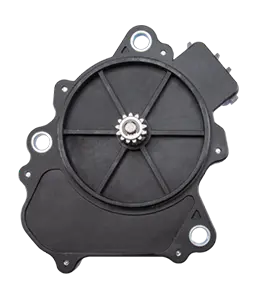An electric sunroof motor is necessary for the automatic opening and closing of a car sunroof. So, what is the structure of the electric sunroof motor for a car? The electric sunroof mainly comprises a sliding mechanism, a driving mechanism, a control system, and switches. The sliding mechanism of the electric sunroof is mainly composed of guide blocks, guide pins, connecting rods, brackets, and front and rear pillow seats; The driving mechanism is mainly composed of an electric motor, a transmission mechanism, and a sliding screw. The electric motor provides power to the opening and closing of the sunroof through a transmission device, and can rotate in both directions. That is, by changing the direction of the current to change the rotation direction of the electric motor, the sunroof can be opened and closed.

An electric sunroof motor is necessary for the automatic opening and closing of a car sunroof. So, what is the structure of the electric sunroof motor for a car? The electric sunroof mainly comprises a sliding mechanism, a driving mechanism, a control system, and switches. The sliding mechanism of the electric sunroof is mainly composed of guide blocks, guide pins, connecting rods, brackets, and front and rear pillow seats; The driving mechanism is mainly composed of an electric motor, a transmission mechanism, and a sliding screw. The electric motor provides power to the opening and closing of the sunroof through a transmission device, and can rotate in both directions. That is, by changing the direction of the current to change the rotation direction of the electric motor, the sunroof can be opened and closed.
The electric sunroof motor plays a critical role in this entire system. It converts electrical energy into mechanical movement, enabling the smooth operation of the sunroof. Typically, this motor is designed to be compact but powerful enough to handle the weight and resistance of the sunroof panel. It works by engaging with a transmission mechanism—usually a set of gears or a sliding screw—that transfers the motor's rotational motion into the linear motion required to slide the sunroof open or closed. Because the motor can rotate in both directions, reversing the current allows the sunroof to move either forward or backward, providing controlled opening and closing actions.
In addition to the sunroof, the motor DC power window system shares similarities in design and function. Both systems rely on electric motors that convert electrical input into mechanical motion to move window glass or sunroof panels. The motor DC power window is often a compact direct current motor capable of running smoothly and quietly, ensuring user comfort during operation. Like the electric sunroof motor, it includes a transmission mechanism that usually consists of gears and linkages to convert the motor’s rotation into the vertical movement of the window.
One of the key components of the electric sunroof motor system is the transmission mechanism. It must be designed to provide stable and reliable power transfer. Typically, a sliding screw or worm gear mechanism is used. This not only translates rotational motion into linear motion but also offers self-locking capabilities, which means the sunroof can stay in its position without requiring continuous power from the motor. This feature contributes to energy efficiency and safety, preventing accidental opening or closing of the sunroof.
The control system complements the motor and mechanical parts. It consists of electronic circuits and sensors that manage motor operation. For example, when the sunroof switch is activated, the control system sends power to the electric sunroof motor in a specific direction to open or close the roof. Additionally, it monitors the motor’s current and position to detect obstacles or malfunctions. If the motor encounters resistance—such as an obstruction in the sunroof path—the control system can stop or reverse the motor to prevent damage or injury.
In terms of power, electric sunroof motors often operate on the vehicle’s 12-volt DC power supply. This makes them compatible with the existing electrical system of more cars, simplifying integration. The motor DC power window also operates on similar voltage levels, allowing consistent performance across different automotive systems. Both motors are designed to work efficiently at this voltage, balancing power output and energy consumption.
Maintenance of the electric sunroof motor involves ensuring the transmission mechanism is properly lubricated and free from debris. Dirt or lack of lubrication can increase friction, pilot to motor strain, and possible failure. Similarly, the motor DC power window system benefits from regular maintenance to keep the gear teeth and linkages clean and well-lubricated. Regular checks can prolong the lifespan of these motors and maintain smooth operation.
Overall, the electric sunroof motor is a carefully engineered component that integrates electrical, mechanical, and control systems to provide convenient and reliable sunroof operation. Its ability to reverse rotation, combined with a transmission mechanism that converts this motion into the sliding of the sunroof panel, enables drivers and passengers to adjust ventilation and light easily. Alongside the motor DC power window system, these electric motors contribute significantly to the comfort and functionality of modern vehicles.
Your email address will not be published. Required field are marked*